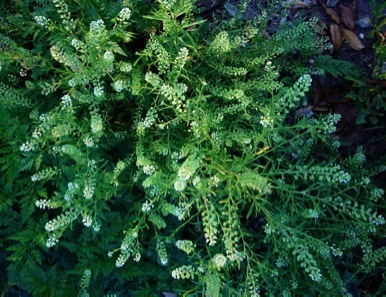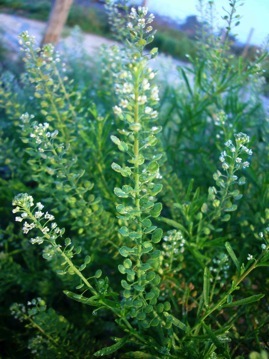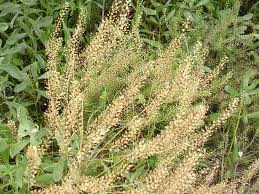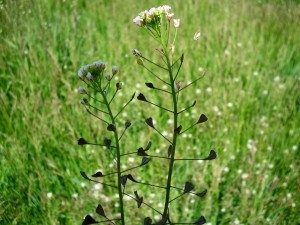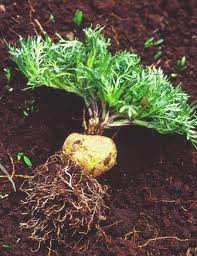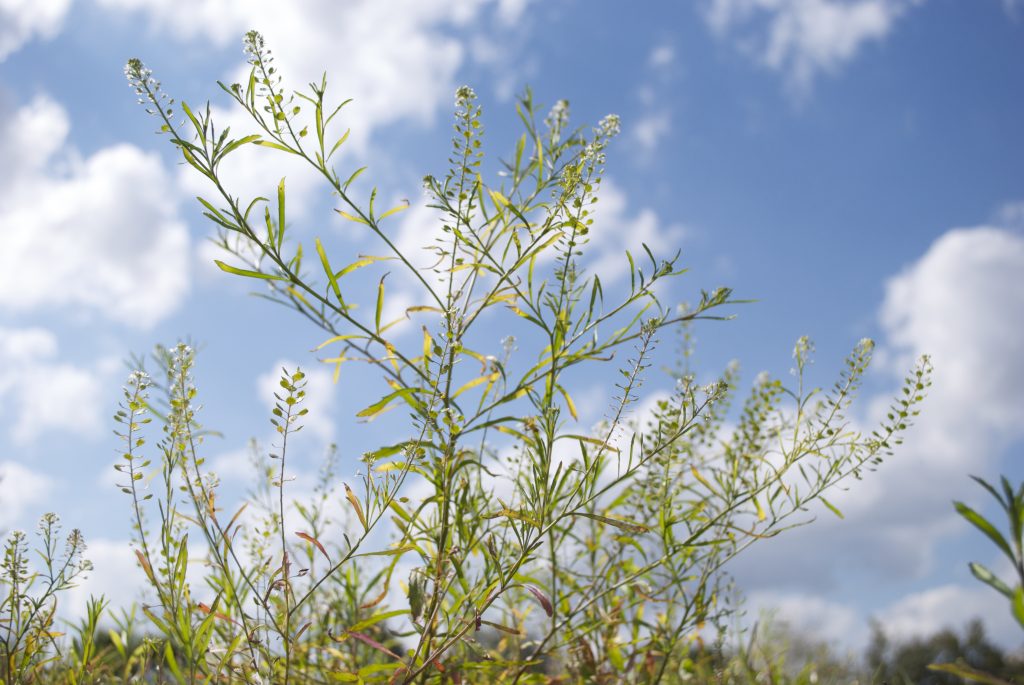
Peppergrass starts as a basal rosette then sends up a flower spike. Photo by Green Deane
Lepidium Virginicum: Bottlebrush Peppergrass
There are two ways of thinking about peppergrass, either as a real neat wild treat, or an obnoxious weed. Regardless of your world view — or weed view — peppergrass is a survivor and part of man’s diet for many thousands of years. As far back as 300 BC Pliny was writing about the Lepidium, and more than a thousand years before that the Incas were cultivating it.
There are about 175 different Lepidiums, no doubt some native to your area and some imported. Growers dislike them because raw they can flavor milk and are herbicide resistant. (Fermented peppergrass, however, is an excellent silage feed for cattle. ) Pictured is “Poor-Man’s-Pepper” Lepidium virginicum (leh-PID-ee-um vir-GIN-i-kum). Virginicum means “North American” and Lepidium is dead Latin’s bastardization of Greek for little fish scale, Lepidion. And indeed, with a little imagination the notched seed pods of the Lepidium can look like little fish scales, some say little purses, I think flat, tiny lentils. Modern Greeks call this (and the related Shepherd’s Purse) kardamo which means cress.
While in many places Lepidium is a winter and spring visitor, it is a year round plant here in Florida though it is most noticeable and happiest in winter here. The young leaves can be added to salads or soups — they are peppery. The seed pods can be used like pepper. The root, ground and mixed with vinegar is a good substitute for horseradish. I like them as a trail side nibble. The leaves contain protein, vitamin A and are rich in Vitamin C. There are no poisonous look-alikes. If you have a Peppergrass with really large seeds it might be Thlaspi arvense, an edible relative.
As with all mustards, it has a tiny four-petal flower, whitish-yellow with two stamen. Bees like them. The flowers are on elongated racemes, which lends them to the classic description of looking like a small bottle brush. The leaves are deeply toothed. First the plant produces a low rosette of deeply cut basal leaves, then vertical growth and seeding. Some species in some places are biennial, rosetting one year, growing up and seeding the next.There are actually four very common Lepidiums and variations in all of North America. The leaves and seeds tell them apart but their use is the same. The shape of the seeds spell T.H.O.R. and that is how I remember them.
The Cow-cress, Lepidium campesire, has basal leaves that embrace the stem — making them rise up — and a seed pod shaped like a front Tooth, with a tiny nick at the end. A close relative, the Shepherd’s Purse, Capsella bursa-pastoris, below, resembles “Poor Mans” but its seed pods are Heart-shaped. “Poor-Man’s Pepper” has deeply toothed leaves and an Ovalish seed pod with a small notch at the end. Pennycress resembles “Poor Man’s” as well, but the seed pods are Round and deeply notched. The common horseradish, that the sauce of the same name is made from, is a relative though it is much larger and has tiny egg-shaped seed pods. That the family is nutritious is just the beginning of the story. There are medical uses, some proven. The L. virginicum is antiamoebic, for example.
In a 2003 study looking for antiprotozoal agents from plants researchers found “a crude extract from the roots of Lepidium virginicum exhibited antiprotozoal activity against Entamoeba histolytica trophozoites,” one nasty bug. “The results support the anecdotal reports for the traditional use of L. virginicum roots in the control of diarrhea and dysentery in the highlands of Chiapas, Mexico.”
Perhaps the most famous Lepidium, however, is Lepidium peruvianum, also know as Maca. It grows a tuber that has been used to “enhance” fertility in man and beast. Research shows it also relieves stress.
Maca is hardy, being cultivated high in the Andes at altitudes from 8,000 to 14,500 feet. It has the highest frost tolerances of all plants and takes seven to nine months to produce a root, which can be eaten fresh or dried. They can be stored dry for as long as seven years. L. peruvianum roots have a tangy, sweet taste similar to butterscotch. In Peru they are eaten as is or made into jam, pudding, porridge, soda even a fermented drink called Maca Chicha.
There is a debate whether the Maca sold today is L. peruvianum or Lepidium meyenii, with the latest opinion favoring peruvianum. Called the “natural viagra” Maca has caught the attention of the non-Peruvian world: In 1994 less than 50 hectares were used in the commercial cultivation of maca; by 1999 over 1200 hectares were under production. It now exceeds 2000 hectares.
Those 2000 hectacres are found high in the Andes, an inhospitable place of intense sunlight, violent winds, and below-freezing weather. With such extreme condition and poor, rocky soil, the area is among the world’s worst farmland. However, Maca evolved to live under those conditions as have most mustards. They can be found growing in Greenland and the Arctic circle. The Incas domesticated Maca about 2,000 years ago, and primitive versions of Maca — early cultivars — have been found in archaeological sites dating back nearly 4,000 years.
If you’re not inclined to eat the peppergrass, then there is another use: the dried seed stems make a great addition to dried arrangements and wreaths. They are showy, sturdy, and last for a long time.
Sometimes you have to approach an edible plant’s nutrition obliquely. Peppergrass is a good example. There’s been research on the plant for inhibiting pathogens but not much on nutrition. However a 1944 study involving silage (cattle food) gives us some insights. (Journal of Dairy Science, Vol 27, Issue 5, pp 365-367.)
There was a heavy stand of Peppergrass (Lepidium virginicum) at the Virginia Agricultural Experiment Station at Blacksburg Virginia. There was too much to let it all go to seed but if they left it it would smother out the alfalfa they were growing. Mowing, racking and hauling it away was costly if no use was found for. So they decided to use it for silage. It was a bold idea because plants in the greater mustard family can taint the flavor of milk.
The ten acres yielded approximately 28 tons of Peppergrass. They mixed it with 50 pounds of molasses per ton as a preservative then let it ferment. At the end of fermentation there was no odor or flavor of peppergrass. They also tested the nutriments of the peppergrass before and after ensilaging. By weight the Peppergrass was 3% potassium, 1.34% calcium, 0.40% magnesium and 0.23% phosphorus. After fermenting the amounts were slightly less. Alfalfa was in the finished silage but the study did not make clear if it was also analyzed with the peppergrass.
As for other nutriments we have to rely on an unpublished report. A newspaper article in June 1990 said a sample of Peppergrass had been sent sent to the University of Florida Herbarium for analysis. The analysis reportedly said Peppergrass was high in vitamin C (as ascorbic acid) a good source of vitamin A (beta carotene) and iron. It was also a good source of protein. This would be in keeping with it as a member of the greater mustard family. There is also a 1951 University of Florida report on B vitamins in common produce and some wild plants. They included Peppergrass. Per 100 gram serving it has 0.045 mg of B1 (thiamin) 0.623 of B2 (riboflavin) and 2.54 mg of B3 (niacin.)
Another thing we can do is look at Peppergrass’ relatives. We have reports on two: Lepidium sativum (Garden Cress) and Capsella bursa-pastoris. Garden Cress per 100 grams of fresh leaves has: 32 calories, 2.6 grams of protein, 0.7 grams of fat, 5.5 grams of carbohydrates, 69 mg of vitamin C (meeting your daily need) and 930 RE of vitamin A. The minerals are 606 mg potassium, 81 mg calcium, 76 mg phosphorus, 14 mg sodium, and 1.3 mg iron.
Here’s a recipe from Leda Meredith who forages in New York City .
Peppergrass Chermoula
Chermoula is a North African marinade that is usually used with seafood. It is also wonderful on steamed vegetables and mixed into whole grain salads.
1 large clove garlic, peeled OR several underground field garlic bulbs
1 tablespoon fresh green peppergrass seedpod discs
1 small hot pepper
1/2 cup fresh cilantro (coriander) leaves
1/4 – 1/2 cup extra-virgin olive oil
1/2 teaspoon salt
1. Place the garlic, peppergrass, chile pepper, and cilantro in a food processor and pulse to finely chop. Scrape down the sides of the food processor bowl with a spatula and pulse again (repeat a few times to end up with a more or less evenly minced mixture).
Alternatively, finely chop the garlic, chile and cilantro. Pound them together with the peppergrass with a mortar and pestle.
2. Add the salt and 1/4 cup of the olive oil and blend. You want to have a slightly liquid paste. Add more olive oil if needed.
Chermoula will keep in the refrigerator for up to 2 months.
Green Deane’s “Itemized” Plant Profile
IDENTIFICATION: Flower: Four petals, two stamen. Fruit: See seed. Leaves: Lobbed, toothed, varies, long to lance shape. Stem: Erect. Seed: Seed pods vary in shape round the stem. Root: Tap root vertical
TIME OF YEAR: Springtime into summer
ENVIRONMENT: Well-drained soil, sandy to rich, old pastures, gardens, lawns, roadside, nearly any sunny spot
METHOD OR PREPARATION: Leaves as potherb, seeds for spice or pepper flavoring, can use flowers to flavor vinegar. Some young leaves can be used raw in salads. Try a little first. Can blanch leaves then saute.

